Meaning
– the reflection of an object, phenomenon, relations in a l-ge.
Types of meaning: 1) lexical (the reflection of a concept in a word
form – goes, went); 2) grammatical ( the reflection of the
relations of obj. in
the
forms of the word – asked, walked); 3) functional (classifies
words, parts of speech – export (n) & export (v). Lexical
meaning: 1) denotational (objective) – the ability of a word to
refer to an individual object; 2) significative (notional, identical)
– the ability of a word to generalize significant properties of
objects & to present them as abstract ideas); 3) connotational
(pragmatic) – the ability of a word to evoke & directly express
emotions; 4) conceptional – scientific meaning. Motivation – a
direct connection between the structure of the word & its
meaning. Types: 1) morphological (re-think – think again); 2) sound
symbolism (sounds associated with words: buzz – жужжать,
cuckoo – куковать); 3) semantic (based on metaphoric
transfer – heart-breaking, eye-wash – надувательство).
5. Change of meaning in English.
Word-meaning
is liable to change in the course of the historical development of
language. Causes
of Semantic Change
-
extra-linguistic
— various
changes in the life of the speech community, changes in economic and
social structure, changes in ideas, scientific concepts, way of life
and other spheres of human activities as reflected in word meanings -
linguistic
—.
factors acting within the language system
-
ellipsis
(In
a phrase made up of two words one of these is omitted and its
meaning is transferred to its partner. The verb to
starve, e.g.,
in Old English had the meaning ‘to die’ and was habitually used
in collocation with the word hunger.
Already
in the 16th century the verb itself acquired the meaning ‘to die
) -
differentiation
of synonyms
(The
word land,
e.g.,
in Old English (OE. land)
meant
both ’solid part of earth’s surface’ and ‘the territory of
a nation’. When in the Middle English period the word country
(OFr.
contree)
was
borrowed as its synonym, the meaning of the word land
was
somewhat altered and ‘the territory of a
nation’
came to be denoted mainly by the borrowed word country) -
linguistic
analogy
— if one of the members of a synonymic set acquires a new meaning
other members of this set change their meanings too. (e.g.,
all English adverbs which acquired the meaning ‘rapidly’ always
develop the meaning ‘immediately’, similarly verbs synonymous
with catch,
e.g. grasp, get, etc.,
by semantic extension acquired another meaning —
‘to
understand’)Nature
of Semantic Change
Generally
speaking, a necessary condition of any semantic change, no matter
what its cause, is some connection, some association between the old
meaning and the new. There are two kinds of association involved as a
rule in various semantic changes namely:
-
Similarity
of meanings or metaphor — a semantic process of associating two
referents, one of which in some way resembles the other.
The word hand,
e.g.,
acquired in the 16th century the meaning of ‘a pointer of a clock
of a watch’ because of the similarity of one of the functions
performed by the hand (to point at something) and the function of
the clockpointer. -
Contiguity
of meanings or metonymy — the semantic process of associating two
referents one of which makes part of the other or is closely
connected with it. (the
word tongue
— ‘the
organ of speech’ in the meaning of ‘language’ (as in mother
tongue; cf.
also L. lingua,
Russ.
язык).
The
word bench
acquired
the meaning ‘judges, magistrates’ because it was on the bench
that
the judges used to sit in law courts, similarly the
House acquired
the meaning of ‘members of the House’ (Parliament)).
Results
of semantic change
can be generally observed in the changes of the denotational meaning
of the word (restriction and extension of meaning) or in the
alteration of its connotational component (amelioration and
deterioration of meaning).Changes
in the denotational meaning
-
restriction
of
the types or range of referents denoted by the word (the
word hound
(OE. hund) which
used to denote ‘a dog of any breed’ but now denotes only ‘a
dog used in the chase’)
-
specialisation
of meaning — if the word with the new meaning comes to be used in
the specialised vocabulary of some limited group within the speech
community it is usual to speak of
(the verb to
glide (OE. glidan) which
had the meaning ‘to move gently and smoothly’ and has now
acquired a restricted and specialised meaning ‘to fly with no
engine’ (cf. a
glider))
-
extension
of meaning—application of the word to a wider variety of
referents.
(the word target
which
originally meant ‘a small round shield’ (a diminutive of targe,
сf.
ON. targa) but
now means ‘anything that is fired at’ and also figuratively ‘any
result aimed at’)
-
generalisation
of
meaning —
the word with the extended meaning passes from the specialised
vocabulary into common use
(The
word camp, which originally was used only as a military term and
meant ‘the place where troops are lodged in tents’ extended and
generalised its meaning and now denotes ‘temporary quarters’ (of
travellers, nomads, etc.)
Changes
in the connotational meaning:
-
pejorativedevelopment
— acquisition by the word of some derogatory emotive charge (the
word boor
was
originally used to denote ‘a villager, a peasant’ and then
acquired a derogatory, contemptuous connotational meaning and came
to denote ‘a clumsy or ill-bred fellow’) -
ameliorative
development — improvement of the connotational component of
meaning.. (the
word minister
which
in one of its meanings originally denoted ‘a servant, an
attendant’, but now —
‘a
civil servant of higher rank, a person administering a department of
state or accredited by one state to another’)
Соседние файлы в предмете [НЕСОРТИРОВАННОЕ]
- #
- #
- #
- #
- #
- #
- #
- #
- #
- #
- #
Скачать материал

Скачать материал


- Сейчас обучается 268 человек из 64 регионов






Описание презентации по отдельным слайдам:
-
1 слайд
Word Meaning
Lecture # 6
Grigoryeva M. -
2 слайд
Word Meaning
Approaches to word meaning
Meaning and Notion (понятие)
Types of word meaning
Types of morpheme meaning
Motivation
-
3 слайд
Each word has two aspects:
the outer aspect
( its sound form)
catthe inner aspect
(its meaning)
long-legged, fury animal with sharp teeth
and claws -
4 слайд
Sound and meaning do not always constitute a constant unit even in the same language
EX a temple
a part of a human head
a large church -
5 слайд
Semantics (Semasiology)
Is a branch of lexicology which studies the
meaning of words and word equivalents -
6 слайд
Approaches to Word Meaning
The Referential (analytical) approachThe Functional (contextual) approach
Operational (information-oriented) approach
-
7 слайд
The Referential (analytical) approach
formulates the essence of meaning by establishing the interdependence between words and things or concepts they denotedistinguishes between three components closely connected with meaning:
the sound-form of the linguistic sign,
the concept
the actual referent -
8 слайд
Basic Triangle
concept (thought, reference) – the thought of the object that singles out its essential features
referent – object denoted by the word, part of reality
sound-form (symbol, sign) – linguistic sign
concept – flowersound-form referent
[rәuz] -
9 слайд
In what way does meaning correlate with
each element of the triangle ?In what relation does meaning stand to
each of them? -
10 слайд
Meaning and Sound-form
are not identical
different
EX. dove — [dΛv] English sound-forms
[golub’] Russian BUT
[taube] German
the same meaning -
11 слайд
Meaning and Sound-form
nearly identical sound-forms have different meanings in different languages
EX. [kot] Russian – a male cat
[kot] English – a small bed for a childidentical sound-forms have different meanings (‘homonyms)
EX. knight [nait]
night [nait] -
12 слайд
Meaning and Sound-form
even considerable changes in sound-form do not affect the meaningEX Old English lufian [luvian] – love [l Λ v]
-
13 слайд
Meaning and Concept
concept is a category of human cognitionconcept is abstract and reflects the most common and typical features of different objects and phenomena in the world
meanings of words are different in different languages
-
14 слайд
Meaning and Concept
identical concepts may have different semantic structures in different languagesEX. concept “a building for human habitation” –
English Russian
HOUSE ДОМ+ in Russian ДОМ
“fixed residence of family or household”
In English HOME -
15 слайд
Meaning and Referent
one and the same object (referent) may be denoted by more than one word of a different meaning
cat
pussy
animal
tiger -
16 слайд
Meaning
is not identical with any of the three points of the triangle –
the sound form,
the concept
the referentBUT
is closely connected with them. -
17 слайд
Functional Approach
studies the functions of a word in speech
meaning of a word is studied through relations of it with other linguistic units
EX. to move (we move, move a chair)
movement (movement of smth, slow movement)The distriution ( the position of the word in relation to
others) of the verb to move and a noun movement is
different as they belong to different classes of words and
their meanings are different -
18 слайд
Operational approach
is centered on defining meaning through its role in
the process of communicationEX John came at 6
Beside the direct meaning the sentence may imply that:
He was late
He failed to keep his promise
He was punctual as usual
He came but he didn’t want toThe implication depends on the concrete situation
-
19 слайд
Lexical Meaning and Notion
Notion denotes the reflection in the mind of real objectsNotion is a unit of thinking
Lexical meaning is the realization of a notion by means of a definite language system
Word is a language unit -
20 слайд
Lexical Meaning and Notion
Notions are international especially with the nations of the same cultural levelMeanings are nationally limited
EX GO (E) —- ИДТИ(R)
“To move”
BUT !!!
To GO by bus (E)
ЕХАТЬ (R)EX Man -мужчина, человек
Она – хороший человек (R)
She is a good person (E) -
21 слайд
Types of Meaning
Types of meaninggrammatical
meaninglexico-grammatical
meaning
lexical meaning
denotational
connotational -
22 слайд
Grammatical Meaning
component of meaning recurrent in identical sets of individual forms of different wordsEX. girls, winters, toys, tables –
grammatical meaning of pluralityasked, thought, walked –
meaning of past tense -
23 слайд
Lexico-grammatical meaning
(part –of- speech meaning)
is revealed in the classification of lexical items into:
major word classes (N, V, Adj, Adv)
minor ones (artc, prep, conj)words of one lexico-grammatical class have the same paradigm
-
24 слайд
Lexical Meaning
is the meaning proper to the given linguistic unit in all its forms and distributionsEX . Go – goes — went
lexical meaning – process of movement -
25 слайд
PRACTICE
Group the words into 3 column according to the grammatical, lexical or part-of –speech meaning
Boy’s, nearest, at, beautiful,
think, man, drift, wrote,
tremendous, ship’s, the most beautiful,
table, near, for, went, friend’s,
handsome, thinking, boy,
nearer, thought, boys,
lamp, go, during. -
26 слайд
Grammatical
The case of nouns: boy’s, ship’s, friend’s
The degree of comparison of adj: nearest, the most beautiful
The tense of verbs: wrote, went, thoughtLexical
Think, thinking, thought
Went, go
Boy’s, boy, boys
Nearest, near, nearer
At, for, during (“time”)
Beautiful, the most beautifulPart-of-speech
Nouns—verbs—adj—-prep -
27 слайд
Aspects of Lexical meaning
The denotational aspectThe connotational aspect
The pragmatic aspect
-
28 слайд
Denotational Meaning
“denote” – to be a sign of, stand as a symbol for”establishes the correlation between the name and the object
makes communication possibleEX booklet
“a small thin book that gives info about smth” -
29 слайд
PRACTICE
Explain denotational meaningA lion-hunter
To have a heart like a lion
To feel like a lion
To roar like a lion
To be thrown to the lions
The lion’s share
To put your head in lion’s mouth -
30 слайд
PRACTICE
A lion-hunter
A host that seeks out celebrities to impress guests
To have a heart like a lion
To have great courage
To feel like a lion
To be in the best of health
To roar like a lion
To shout very loudly
To be thrown to the lions
To be criticized strongly or treated badly
The lion’s share
Much more than one’s share
To put your head in lion’s mouth -
31 слайд
Connotational Meaning
reflects the attitude of the speaker towards what he speaks about
it is optional – a word either has it or notConnotation gives additional information and includes:
The emotive charge EX Daddy (for father)
Intensity EX to adore (for to love)
Imagery EX to wade through a book
“ to walk with an effort” -
32 слайд
PRACTICE
Give possible interpretation of the sentencesShe failed to buy it and felt a strange pang.
Don’t be afraid of that woman! It’s just barking!
He got up from his chair moving slowly, like an old man.
The girl went to her father and pulled his sleeve.
He was longing to begin to be generous.
She was a woman with shiny red hands and work-swollen finger knuckles. -
33 слайд
PRACTICE
Give possible interpretation of the sentences
She failed to buy it and felt a strange pang.
(pain—dissatisfaction that makes her suffer)
Don’t be afraid of that woman! It’s just barking!
(make loud sharp sound—-the behavior that implies that the person is frightened)
He got up from his chair moving slowly, like an old man.
(to go at slow speed—was suffering or was ill)
The girl went to her father and pulled his sleeve.
(to move smth towards oneself— to try to attract smb’s attention)
He was longing to begin to be generous.
(to start doing— hadn’t been generous before)
She was a woman with shiny red hands and work-swollen finger knuckles.
(colour— a labourer involved into physical work ,constant contact with water) -
34 слайд
The pragmatic aspect of lexical meaning
the situation in which the word is uttered,
the social circumstances (formal, informal, etc.),
social relationships between the interlocutors (polite, rough, etc.),
the type and purpose of communication (poetic, official, etc.)EX horse (neutral)
steed (poetic)
nag (slang)
gee-gee (baby language) -
35 слайд
PRACTICE
State what image underline the meaningI heard what she said but it didn’t sink into my mind.
You should be ashamed of yourself, crawling to the director like that.
They seized on the idea.
Bill, chasing some skirt again?
I saw him dive into a small pub.
Why are you trying to pin the blame on me?
He only married her for her dough. -
36 слайд
PRACTICE
State what image underline the meaning
I heard what she said but it didn’t sink into my mind.
(to understand completely)
You should be ashamed of yourself, crawling to the director like that.
(to behave humbly in order to win favour)
They seized on the idea.
(to be eager to take and use)
Bill, chasing some skirt again?
(a girl)
I saw him dive into a small pub.
(to enter suddenly)
Why are you trying to pin the blame on me?
(to blame smb unfairly)
He only married her for her dough.
(money) -
37 слайд
Types of Morpheme Meaning
lexical
differential
functional
distributional -
38 слайд
Lexical Meaning in Morphemes
root-morphemes that are homonymous to words possess lexical meaning
EX. boy – boyhood – boyishaffixes have lexical meaning of a more generalized character
EX. –er “agent, doer of an action” -
39 слайд
Lexical Meaning in Morphemes
has denotational and connotational components
EX. –ly, -like, -ish –
denotational meaning of similiarity
womanly , womanishconnotational component –
-ly (positive evaluation), -ish (deragotary) женственный — женоподобный -
40 слайд
Differential Meaning
a semantic component that serves to distinguish one word from all others containing identical morphemesEX. cranberry, blackberry, gooseberry
-
41 слайд
Functional Meaning
found only in derivational affixes
a semantic component which serves to
refer the word to the certain part of speechEX. just, adj. – justice, n.
-
42 слайд
Distributional Meaning
the meaning of the order and the arrangement of morphemes making up the word
found in words containing more than one morpheme
different arrangement of the same morphemes would make the word meaningless
EX. sing- + -er =singer,
-er + sing- = ? -
43 слайд
Motivation
denotes the relationship between the phonetic or morphemic composition and structural pattern of the word on the one hand, and its meaning on the othercan be phonetical
morphological
semantic -
44 слайд
Phonetical Motivation
when there is a certain similarity between the sounds that make up the word and those produced by animals, objects, etc.EX. sizzle, boom, splash, cuckoo
-
45 слайд
Morphological Motivation
when there is a direct connection between the structure of a word and its meaning
EX. finger-ring – ring-finger,A direct connection between the lexical meaning of the component morphemes
EX think –rethink “thinking again” -
46 слайд
Semantic Motivation
based on co-existence of direct and figurative meanings of the same wordEX a watchdog –
”a dog kept for watching property”a watchdog –
“a watchful human guardian” (semantic motivation) -
-
48 слайд
Analyze the meaning of the words.
Define the type of motivation
a) morphologically motivated
b) semantically motivatedDriver
Leg
Horse
Wall
Hand-made
Careless
piggish -
49 слайд
Analyze the meaning of the words.
Define the type of motivation
a) morphologically motivated
b) semantically motivated
Driver
Someone who drives a vehicle
morphologically motivated
Leg
The part of a piece of furniture such as a table
semantically motivated
Horse
A piece of equipment shaped like a box, used in gymnastics
semantically motivated -
50 слайд
Wall
Emotions or behavior preventing people from feeling close
semantically motivated
Hand-made
Made by hand, not machine
morphologically motivated
Careless
Not taking enough care
morphologically motivated
Piggish
Selfish
semantically motivated -
51 слайд
I heard what she said but it didn’t sink in my mind
“do down to the bottom”
‘to be accepted by mind” semantic motivationWhy are you trying to pin the blame on me?
“fasten smth somewhere using a pin” –
”to blame smb” semantic motivationI was following the man when he dived into a pub.
“jump into deep water” –
”to enter into suddenly” semantic motivationYou should be ashamed of yourself, crawling to the director like that
“to move along on hands and knees close to the ground” –
“to behave very humbly in order to win favor” semantic motivation
Найдите материал к любому уроку, указав свой предмет (категорию), класс, учебник и тему:
6 210 150 материалов в базе
- Выберите категорию:
- Выберите учебник и тему
- Выберите класс:
-
Тип материала:
-
Все материалы
-
Статьи
-
Научные работы
-
Видеоуроки
-
Презентации
-
Конспекты
-
Тесты
-
Рабочие программы
-
Другие методич. материалы
-
Найти материалы
Другие материалы
- 22.10.2020
- 141
- 0
- 21.09.2020
- 530
- 1
- 18.09.2020
- 256
- 0
- 11.09.2020
- 191
- 1
- 21.08.2020
- 197
- 0
- 18.08.2020
- 123
- 0
- 03.07.2020
- 94
- 0
- 06.06.2020
- 73
- 0
Вам будут интересны эти курсы:
-
Курс повышения квалификации «Формирование компетенций межкультурной коммуникации в условиях реализации ФГОС»
-
Курс профессиональной переподготовки «Клиническая психология: теория и методика преподавания в образовательной организации»
-
Курс повышения квалификации «Введение в сетевые технологии»
-
Курс повышения квалификации «История и философия науки в условиях реализации ФГОС ВО»
-
Курс повышения квалификации «Основы построения коммуникаций в организации»
-
Курс повышения квалификации «Организация практики студентов в соответствии с требованиями ФГОС медицинских направлений подготовки»
-
Курс повышения квалификации «Правовое регулирование рекламной и PR-деятельности»
-
Курс повышения квалификации «Организация маркетинга в туризме»
-
Курс повышения квалификации «Источники финансов»
-
Курс профессиональной переподготовки «Техническая диагностика и контроль технического состояния автотранспортных средств»
-
Курс профессиональной переподготовки «Осуществление и координация продаж»
-
Курс профессиональной переподготовки «Технический контроль и техническая подготовка сварочного процесса»
-
Курс профессиональной переподготовки «Управление качеством»
- Размер: 250 Кб
- Количество слайдов: 17
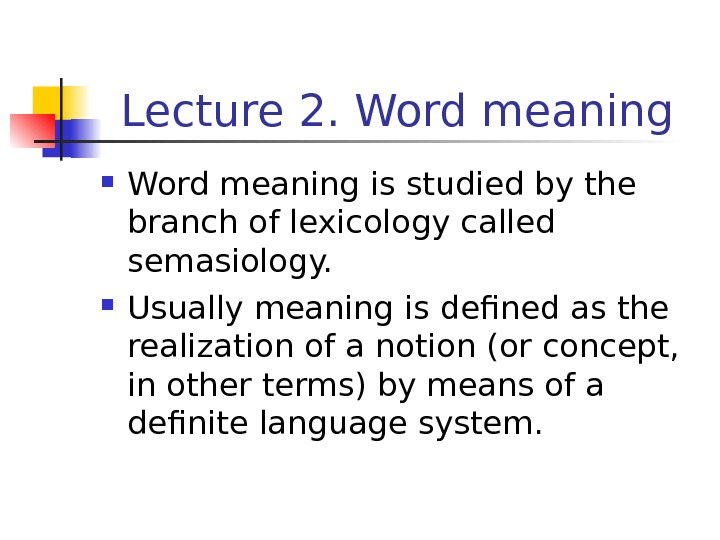
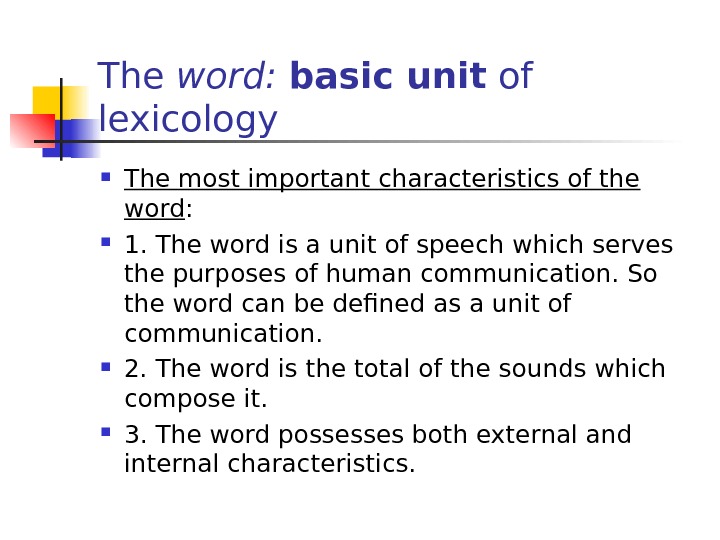
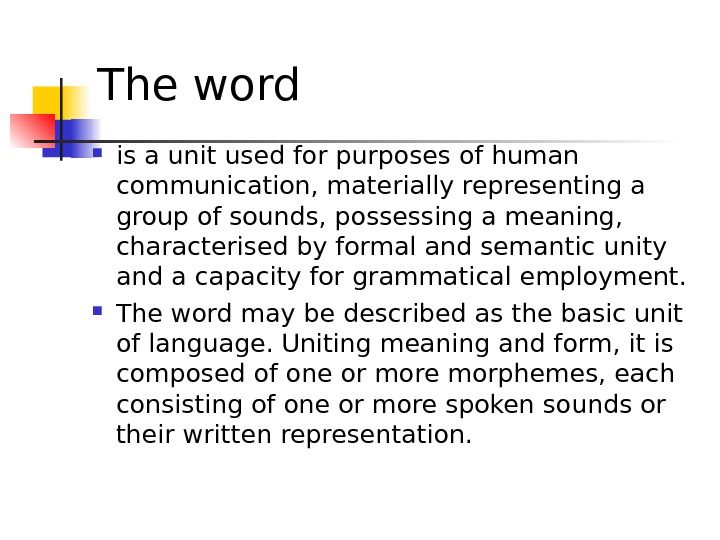
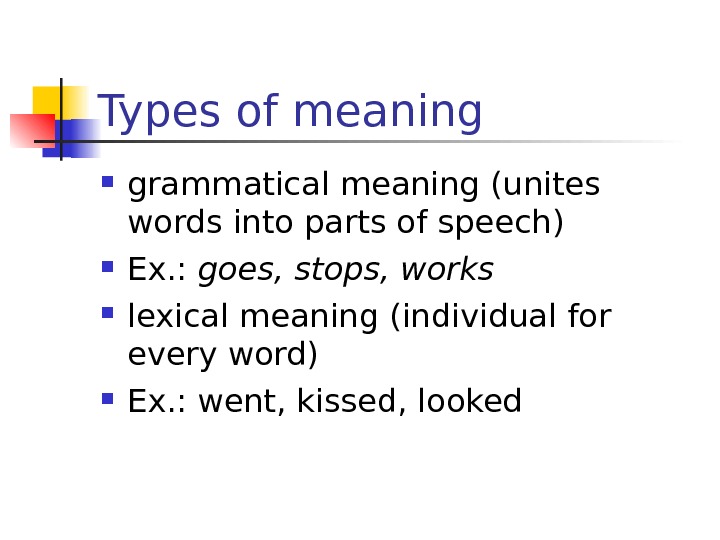
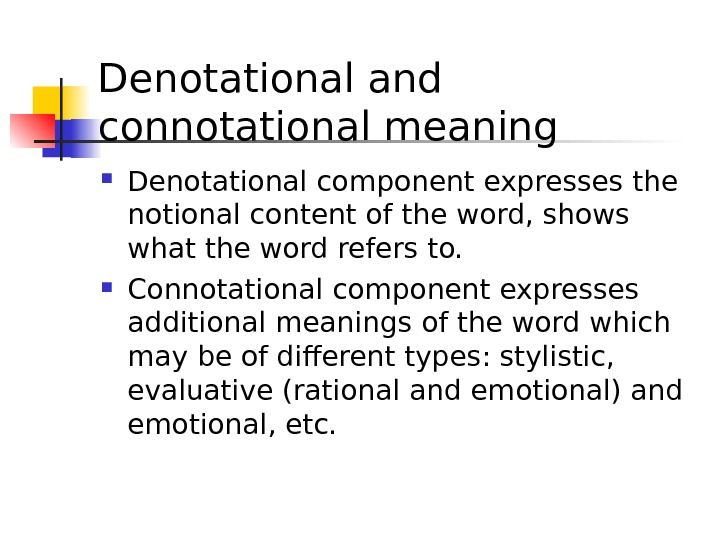


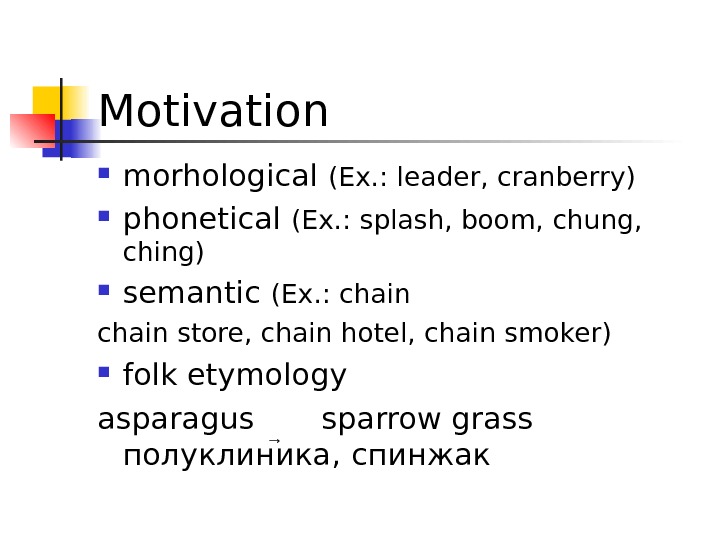

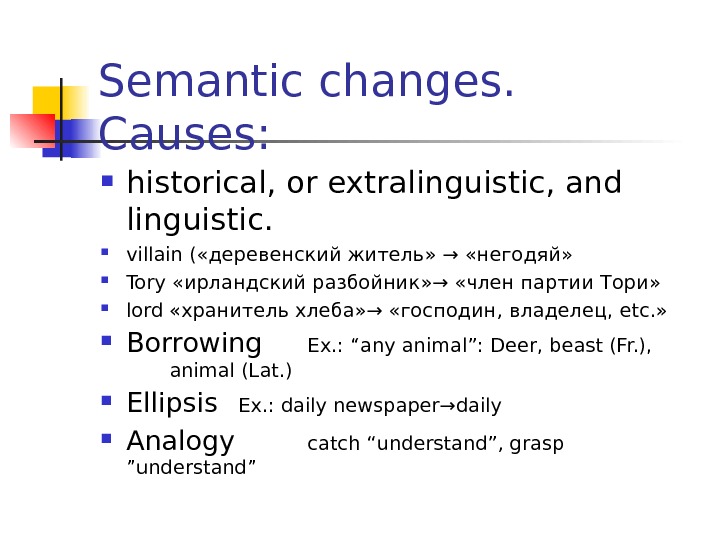
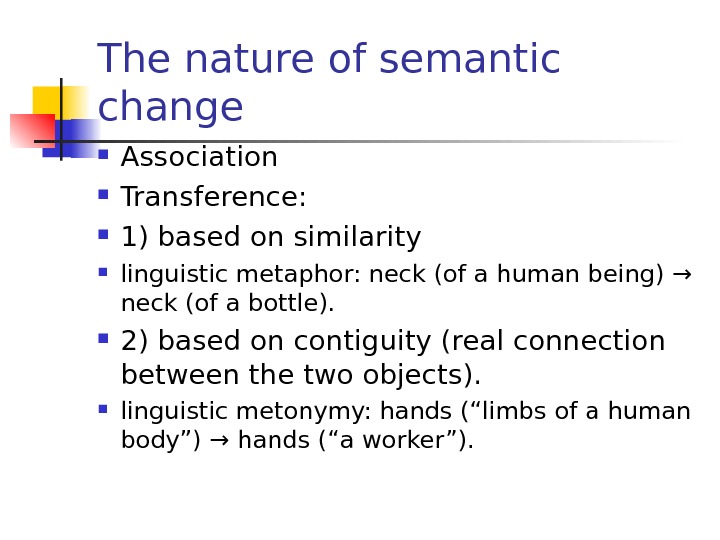
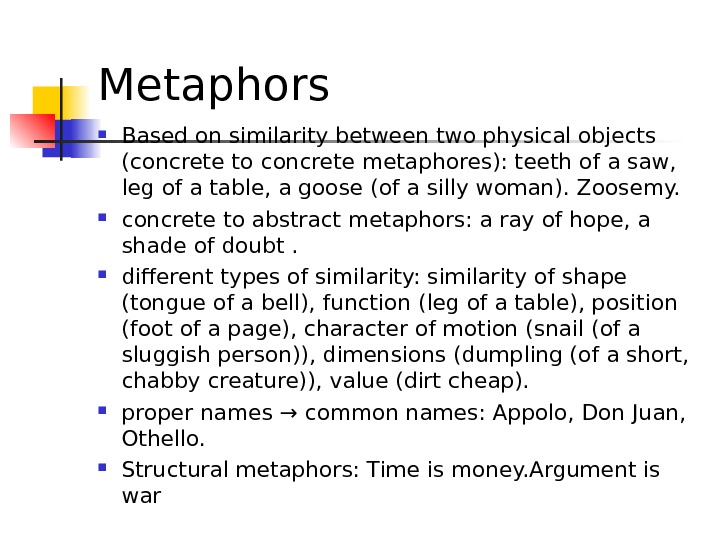



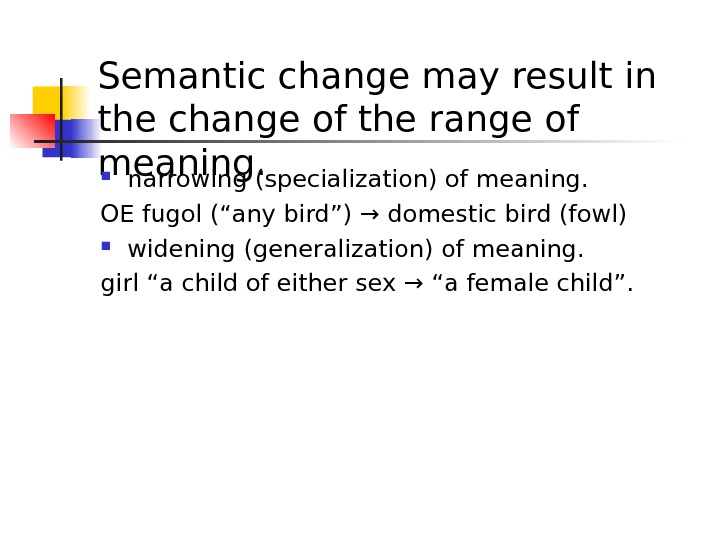
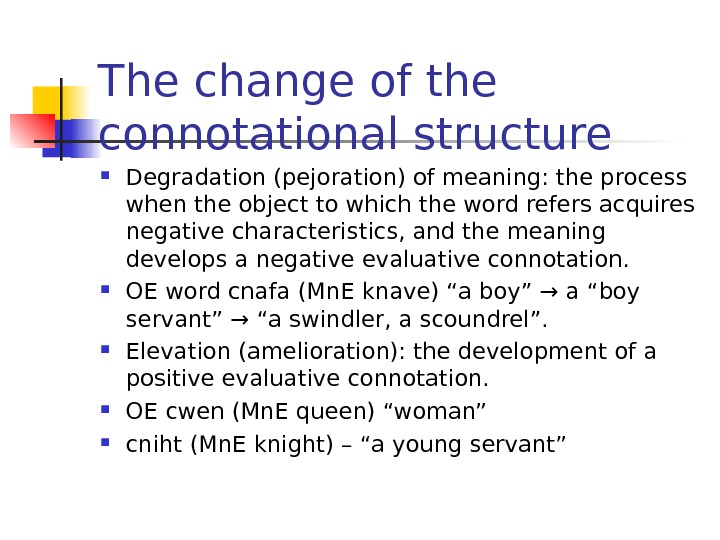
3.1. The object of semasiology. Two approaches to the study of meaning.
3.2. Types of meaning.
3.3. Meaning and motivation.
3.1. The branch of lexicology which studies meaning is called » semasiology «. Sometimes the term » semantics » is used as a synonym to semasiology, but it is ambiguous as it can stand as well for (1) the expressive aspect of language in general and (2) the meaning of one particular word.
Meaning is certainly the most important property of the word but what is » meaning»?
Meaning is one of the most controversial terms in lexicology. At present there is no generally accepted definition of meaning. Prof. Smirnitsky defines meaning as » a certain reflection in the mind of objects, phenomena or relations that makes part of the linguistic sign, its so-called inner facet, whereas the sound form functions as its outer facet». Generally speaking, meaning can be described as a component of the word through which a concept is communicated, enabling the word to denote objects in the real world.
There are two approaches to the study of meaning: the referential approach and the functional approach. The former tries to define meaning in terms of relations between the word (sound form), concept (notion, thought) and referent (object which the word denotes). They are closely connected and the relationship between them is represented by » the semiotic triangle» (= the basic triangle) of Ogden and Richards (in the book » The Meaning of Meaning» (1923) by O.K. Ogden and I.A. Richards).


 |
symbol referent
(sound form)
This view denies a direct link between words and things, arguing that the relationship can be made only through the use of our minds. Meaning is related to a sound form, concept and referent but not identical with them: meaning is a linguistic phenomenon while neither concept nor referent is.
The main criticism of this approach is the difficulty of identifying » concepts»: they are mental phenomena and purely subjective, existing in the minds of individuals. The strongest point of this approach is that it connects meaning and the process of nomination.
The functional approach to meaning is less concerned with what meaning is than with how it works. It is argued, to say that » words have meanings» means only that they are used in a certain way in a sentence. There is no meaning beyond that. Ludwig Wittgenstein (1889-1951), in particular, stressed the importance of this approach in his dictum: » The meaning of the word is its use in the language». So meaning is studied by making detailed analyses of the way words are used in contexts, through their relations to other words in speech, and not through their relations to concepts or referents.
Actually, the functional approach is basically confined to the analysis of sameness or difference of meaning. For example, we can say that in » take the bottle » and » take to the bottle » take has different meaning as it is used differently, but it does not explain what the meaning of the verb is. So the functional approach should be used not as the theoretical basis for the study of meaning, but only as complementary to the referential approach.
3.2. Word meaning is made up of different components, commonly known as types of meaning. The two main types of meaning are grammatical meaning and lexical meaning.
Grammatical meaning belongs to sets of word-forms and is common to all words of the given part of speech,
e.g. girls, boys, classes, children, mice express the meaning of » plurality».
Lexical meaning belongs to an individual word in all its forms. It comprises several components. The two main ones are the denotational component and the connotational component.
The denotational (= denotative) component, also called » referential meaning» or » cognitive meaning», expresses the conceptual (notional) content of a word; broadly, it is some information, or knowledge, of the real-world object that the word denotes. Basically, this is the component that makes communication possible.
e.g. notorious » widely-known», celebrated » known widely».
The connotational (connotative) component expresses the attitude of the speaker to what he is saying, to the object denoted by the word. This component consists of emotive connotation and evaluative connotation.
1) Emotive connotation (= » affective meaning», or an emotive charge),
e.g. In » a single tree » single states that there is only one tree, but » a lonely tree » besides giving the same information, also renders (conveys) the feeling of sadness.
We shouldn’t confuse emotive connotations and emotive denotative meanings in which some emotion is named, e.g. horror, love, fear, etc.
2) Evaluative connotation labels the referent as » good» or » bad»,
e.g. notorious has a negative evaluative connotation, while celebrated a positive one. Cf.: a notorious criminal/liar/ coward, etc. and a celebrated singer/ scholar/ artist, etc.
It should be noted that emotive and evaluative connotations are not individual, they are common to all speakers of the language. But emotive implications are individual (or common to a group of speakers), subjective, depend on personal experience.
e.g. The word » hospital » may evoke all kinds of emotions in different people (an architect, a doctor, an invalid, etc.)
Stylistic connotation, or stylistic reference, another component of word meaning, stands somewhat apart from emotive and evaluative connotations. Indeed, it does not characterize a referent, but rather states how a word should be used by referring it to a certain functional style of the language peculiar to a specific sphere of communication. It shows in what social context, in what communicative situations the word can be used.
Stylistically, words can be roughly classified into literary, or formal (e.g. commence, discharge, parent), neutral (e.g. father, begin, dismiss) and non-literary, or informal (e.g. dad, sack, set off).
3.3. The term » motivation » is used to denote the relationship between the form of the word, i.e. its sound form, morphemic composition and structural pattern, and its meaning.
There are three main types of motivation: phonetic, morphological and semantic.
1) Phonetic motivation is a direct connection between the sound form of a word and its meaning. There are two types of phonetic motivation: sound imitation and sound symbolism.
a) Sound imitation, or onomatopoeia: phonetically motivated words are a direct imitation of the sounds they denote (or the sounds produced by actions or objects they denote),
e.g. buzz, swish, bang, thud, cuckoo.
b) Sound symbolism. It’s argued by some linguists that the sounds that make up a word may reflect or symbolise the properties of the object which the word refers to, i.e. they may suggest size, shape, speed, colour, etc.
e.g. back vowels suggest big size, heavy weight, dark colour, front vowels suggest lightness, smallness, etc.
Many words beginning with sl- are slippery in some way: slide, slip, slither, sludge, etc. or pejorative: slut, slattern, sly, sloppy, slovenly; words that end in -ump almost all refer to some kind of roundish mass: plump, chump, rump, hump, stump.
Certainly, not every word with these phonetic characteristics will have the meaning suggested. This is, perhaps, one of the reasons why sound symbolism is not universally recognized in linguistics.
2) Morphological motivation is a direct connection between the lexical meaning of the component morphemes, the pattern of their arrangement and the meaning of the word.
Morphologically motivated words are those whose meaning is determined by the meaning of their components,
e.g. re-write » write again», ex-wife » former wife».
The degree of morphological motivation may be different. Words may be fully motivated (then they are transparent), partially motivated and non-motivated (idiomatic, or opaque).
a) If the meaning of the word is determined by the meaning of the components and the structural pattern, it is fully motivated: e.g. hatless.
b) If the connection between the morphemic composition of a word and its meaning is arbitrary, the word is non-motivated, e.g. buttercup » yellow-flowered plant».
c) In hammer -er shows that it is an instrument, but what is » hamming «? » Ham » has no lexical meaning in this word, thus the word is partially motivated. Cf. also cranberry.
Motivation may be lost in the course of time,
e.g. in OE wī fman was motivated morphologically: wī f + man » wife of a man»; now it is opaque; its motivation is said to be faded (woman).
3) Semantic motivation is based on co-existence of direct and figurative meanings of the same word,
e.g. butterfly – 1) insect; 2) showy and frivolous person.(= metaphorical extension of the direct meaning).
|
Аальтернативная стоимость. Кривая производственных возможностей В экономике Буридании есть 100 ед. труда с производительностью 4 м ткани или 2 кг мяса… |
Вычисление основной дактилоскопической формулы Вычислением основной дактоформулы обычно занимается следователь. Для этого все десять пальцев разбиваются на пять пар… |
Расчетные и графические задания Равновесный объем — это объем, определяемый равенством спроса и предложения… |
Кардиналистский и ординалистский подходы Кардиналистский (количественный подход) к анализу полезности основан на представлении о возможности измерения различных благ в условных единицах полезности… |
|
Прием и регистрация больных Пути госпитализации больных в стационар могут быть различны. В центральное приемное отделение больные могут быть доставлены: ПУНКЦИЯ И КАТЕТЕРИЗАЦИЯ ПОДКЛЮЧИЧНОЙ ВЕНЫ Ситуация 26. ПРОВЕРЕНО МИНЗДРАВОМ |
1. Word Meaning
1. Two schools of thought.
2. Denotation and connotation. Types of
connotation.
3. Polysemy.
4. Semantic changes (metaphor,
metonymy, narrowing /specialization,
broadening /generalization).
5. Secondary ways of semantic change.
2.
• The term semasiology comes from Greek
sema «sign» + semantikos «significant»
• It was introduced into linguistic studies in
1825 by the classical scholar C. Reisig
who set up a new division of grammar
(semasiology, etymology and syntax).
• He regarded semasiology as a historical
discipline that should establish the
principles of governing the
development of meaning.
3.
• In 1883 Michel Breal (the French
philologist) published an article in which
he argued that there ought to be a
science of meaning which he proposed
to call semasiology.
• In 1897 he published his book which
soon spread to other languages and in
1900 after its publication was translated
into English under the title: Semantics:
Studies in the Science of Meaning.
4.
• Another famous book on semantics is The
meaning of meaning by С. К. Ogden and I. A.
Richards published in 1923.
• The term semantics was first used to refer to
the development and change of meaning. It
is originated from Greek word «semantikos»
(«significant“).
• It is the study of meanings – dealing with the
relationship between symbols (words, signs,
etc.) and what they refer to (‘referents’) – and
of behavior in reaction to non-verbal
symbols and verbal symbols (words).
5. Two schools of thought
• relative or
functional
approach
• denotational or
referential
approach
• The relative approach is based on treating the
language as a semiotic system – the theory of
relations .
• The denotational trend of semantic studies
considers a word as a unit possessing its own
meaning.
6. Relative approach
• Each sign achieves a meaning only in
comparison with other signs, its neighbours:
meaning can be studied only through context.
CONTEXT
Extra-linguistic
Linguistic
Lexical
Grammatical
Mixed
7. Referential approach
• The main problem is the relation
between the word, its meaning and the
object in reality which it denotes.
• The basis of the denotational theory is
the double nature (ideal and material) of
the word.
• The material side of the word (symbol),
its meaning, and the referent are
connected with one another.
8.
• The meaning of a word is the reflection of the
objective reality in our consciousness.
Concept-notion
Linguistic sign
Referent
• The word is a form of a notion’s material
existence.
9.
• Every word has two aspects: the outer
aspect (its sound form) and the inner
aspect (its meaning).
• The lexical meaning of a word is the
realization of a notion by means of a
definite language system.
• A word is a language unit, while a
notion is a unit of thinking.
• A notion denotes the reflection in the
mind of real objects and phenomena in
their essential features and relations.
10.
• Notions, as a rule, are international.
• Meanings can be nationally limited.
• The development of lexical
meanings in any language, as well
as the grouping of meanings in
the semantic structure of a word, is
determined by the whole system
of every language.
11.
• Word meaning is made up of various
components. There are 2 important elements
of the meaning:
denotation
connotation
• the denotational – the realization of the notion
(which makes communication possible) and
the connotational – the pragmatic
communicative value of the word.
12.
• The denotation of a word is the direct
explicit meaning that makes
communication possible.
• When we say that a word denotes
something, we mean that it is the name
of a thing.
• To denote is to serve as a linguistic
expression for a concept.
• The conceptual content of a word is
expressed in its denotative meaning.
13.
• The connotation of a word is what the word
implies in addition to its denotational meaning.
It is the set of associations that a word’s use
can evoke:
• a hovel denotes «a small house» and besides
implies that it is a miserable dwelling place,
dirty, in bad repair, and, in general, unpleasant
to live in.
• We call connotation what the word conveys
about the speaker’s attitude to the social
circumstances and the appropriate functional
style, about his approval or disapproval of the
object spoken, or the degree of intensity.
14.
There are 4 main types of connotation:
stylistic (to beat it – to retire, horse –
steed),
emotive (dog – doggie),
evaluative (famous/ well-known –
notorious), and
expressive or intensifying (splendid,
superb, fantastic, beastly, etc. are used
colloquially as terms of exaggeration).
We can also speak of pragmatic
connotations, i.e., those of duration,
manner, attending circumstances, etc.
15.
• The connotation is the idea suggested by its
place near /in association with other words or
phrases.
• Childlike and childish both have the
denotation of «like or characteristic of a
child». However the two words have their own
connotations.
• Childlike suggests the favourable qualities
considered typical of a child: innocence and
trustworthiness.
• Childish connotes the unfavourable
characteristics of a child: foolishness or
immaturity.
16.
• The context of the word can also help to
reveal the general and added meanings.
The context is the part of the statement in
which the word or passage at issue
occurs, that which leads up to and follows
a particular expression:
• The actress captured perfectly the
character’s childlike qualities in her
performance.
• Your childish behaviour is quite
annoying in a grown person.
17.
• Denotative and connotative
components make up the semantic
structure (or semantic paradigm) of a
word which is presented by a structure
of semes.
• A seme is the smallest unit of
meaning.
• Thus, the meaning of the word giggle
includes semes of action, living
being and sex, negative evaluation
and intensity.
18.
• KEY TERMS: semasiology, semantics,
relative, referential, denotation,
connotation, seme.
• Антрушина Г.Б., Афанасьева О.В.,
Морозова Н.Н. Лексикология
английского языка. – стр. 147-151; 193197.
• Елисеева В.В. Лексикология
английского языка.









![Meaning and Sound-formare not identical
different
EX. dove - [dΛv]... Meaning and Sound-formare not identical
different
EX. dove - [dΛv]...](https://documents.infourok.ru/2d0c9b9d-1c12-4da2-8c1e-80496902c301/slide_10.jpg)













































